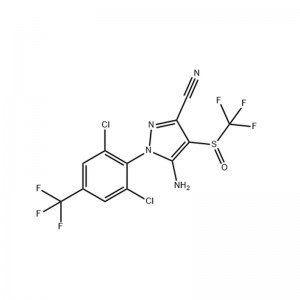
Products
Uracil China Fipronil Manufacture Supplier – Longo Detail:
Structural Formula

Physical
Appearance: white powder
Density: 1.477-1.626
Melting point: 200-201°C
Boiling point: 510.4±50.0°C
Safety Data
Hazardous category: Dangerous goods
Dangerous goods transport number: 2588
Packing category.
Application
It is mainly used in rice, sugarcane, potatoes and other crops. In animal health care, it is mainly used to kill fleas, lice and other parasites on cats and dogs.
Fipronil, an organic compound with the chemical formula C12H4Cl2F6N4OS, is a phenyl pyrazole insecticide with a wide insecticidal spectrum, mainly toxic to pests by stomach, but also has a touch and some endosmosis. It has high insecticidal activity and is not harmful to crops. It can be applied to the soil or as a foliar spray. It can be applied to soil to effectively control corn leaf beetle, golden needle and ground tiger. When foliar spray is applied, it has high level of effectiveness against small vegetable moth, vegetable butterfly, rice thrips, etc., and has a long duration of effect.
In recent years, fipronil has also been widely used as a sanitary insecticide. It is mainly used to prevent and kill cockroaches, ants and other harmful organisms.
Usage:Fipronil has a wide insecticidal spectrum, with touch, stomach poisoning and moderate internal absorption. It can control both underground pests and above-ground pests. It can be used for both stem treatment and soil treatment, and also for seed treatment. 25~50g active ingredient/ha foliar spray can effectively control potato leaf beetle, chokecherry moth, pink boll weevil, Mexican cotton boll weevil and flower thrips, etc. In rice fields, 50~100g/ha of active ingredient can control stem borer, brown fly, etc. 6~15g/ha of active ingredient can control locusts and desert locusts. 100~150g/ha of active ingredient applied to soil can control corn root leaf beetle, golden needle and ground tiger effectively. 250~650g/100kg of active ingredient/100kg of seeds treated with It can effectively control maize golden needle beetle and ground tiger. The main targets of this product include aphids, leafhoppers, lepidopteran larvae, flies and coleopterans. It is one of the preferred varieties recommended by many pesticide experts as a substitute for highly toxic organophosphorus pesticides.
Product detail pictures:

Related Product Guide:
We hold strengthening and perfecting our items and repair. At the same time, we get the job done actively to do research and progress for Uracil China Fipronil Manufacture Supplier – Longo , The product will supply to all over the world, such as: Oslo, Florence, Mombasa, We welcome you to visit our company, factory and our showroom displayed various products that will meet your expectation, meanwhile, it is convenient to visit our website, our sales staff will try their efforts to provide you whole heartedly service. If you need more information, please do not hesitate to contact us by E-mail or telephone.
Good quality, reasonable prices, rich variety and perfect after-sales service, it's nice!






